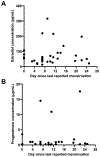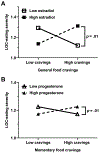Food cravings and loss-of-control eating in youth: Associations with gonadal hormone concentrations
- PMID: 33942921
- PMCID: PMC8355041
- DOI: 10.1002/eat.23530
Food cravings and loss-of-control eating in youth: Associations with gonadal hormone concentrations
Abstract
Objective: Among youth with overweight, food cravings (FC) are associated with loss-of-control (LOC)-eating, but the impact of sex-associated biological characteristics on this relationship is unknown. We examined whether sex and gonadal hormone concentrations moderated the relationships between FC and LOC-eating severity among healthy boys and girls across the weight strata in natural and laboratory environments.
Method: Using ecological momentary assessment (EMA), FC, and LOC-eating severity were reported 3-5 times a day for 2 weeks. In the laboratory, participants reported FC, consumed lunch from a buffet test meal designed to simulate LOC-eating, and rated LOC-eating severity during the meal.
Results: Eighty-seven youth (13.0 ± 2.7 years, 58.6% female, 32.2% with overweight/obesity) participated. EMA measured general and momentary FC were positively associated with LOC-eating severity (ps < .01), with no differences by sex (ps = .21-.93). Estradiol and progesterone significantly moderated the relationships between FC and LOC-eating such that general FC and LOC-eating severity were only positively associated among girls with greater (vs. lower) estradiol (p = .01), and momentary FC and LOC-eating severity were only positively associated among girls with greater (vs. lower) progesterone (p = .01). Boys' testosterone did not significantly moderate the associations between FC and LOC-eating severity (ps = .36-.97). At the test meal, pre-meal FC were positively related to LOC-eating severity (p < .01), without sex or hormonal moderation (ps = .20-.64).
Discussion: FC were related to LOC-eating severity in boys and girls. In the natural environment, gonadal hormones moderated this relationship in girls, but not boys. The mechanisms through which gonadal hormones might affect the relationship between FC and LOC-eating warrant investigation.
Keywords: adolescents; children; ecological momentary assessment; estradiol; food cravings; gonadal hormones; laboratory intake; loss-of-control eating; sex; testosterone.
© 2021 Wiley Periodicals LLC. This article is a U.S. Government work and is in the public domain in the USA.
Conflict of interest statement
CONFLICT OF INTEREST: The authors have no conflict of interest to disclose.
Figures



References
-
- American Psychiatric Association. (2013). Diagnostic and statistical manual of mental disorders (5th ed.). Washington, DC.
-
- Bates D, Mächler M, Bolker B, & Walker S (2015). Fitting Linear Mixed-Effects Models Using lme4. Journal of Statistical Software, 67(1), 1–48. doi:10.18637/jss.v067.i01 - DOI
-
- Bonat S, Pathomvanich A, Keil MF, Field AE, & Yanovski JA (2002). Self-assessment of pubertal stage in overweight children. Pediatrics, 110(4), 743–747. Retrieved from http://search.ebscohost.com/login.aspx?direct=true&db=mdc&AN=12359788&si... - PubMed
Publication types
MeSH terms
Substances
Grants and funding
LinkOut - more resources
Full Text Sources
Other Literature Sources
Research Materials

